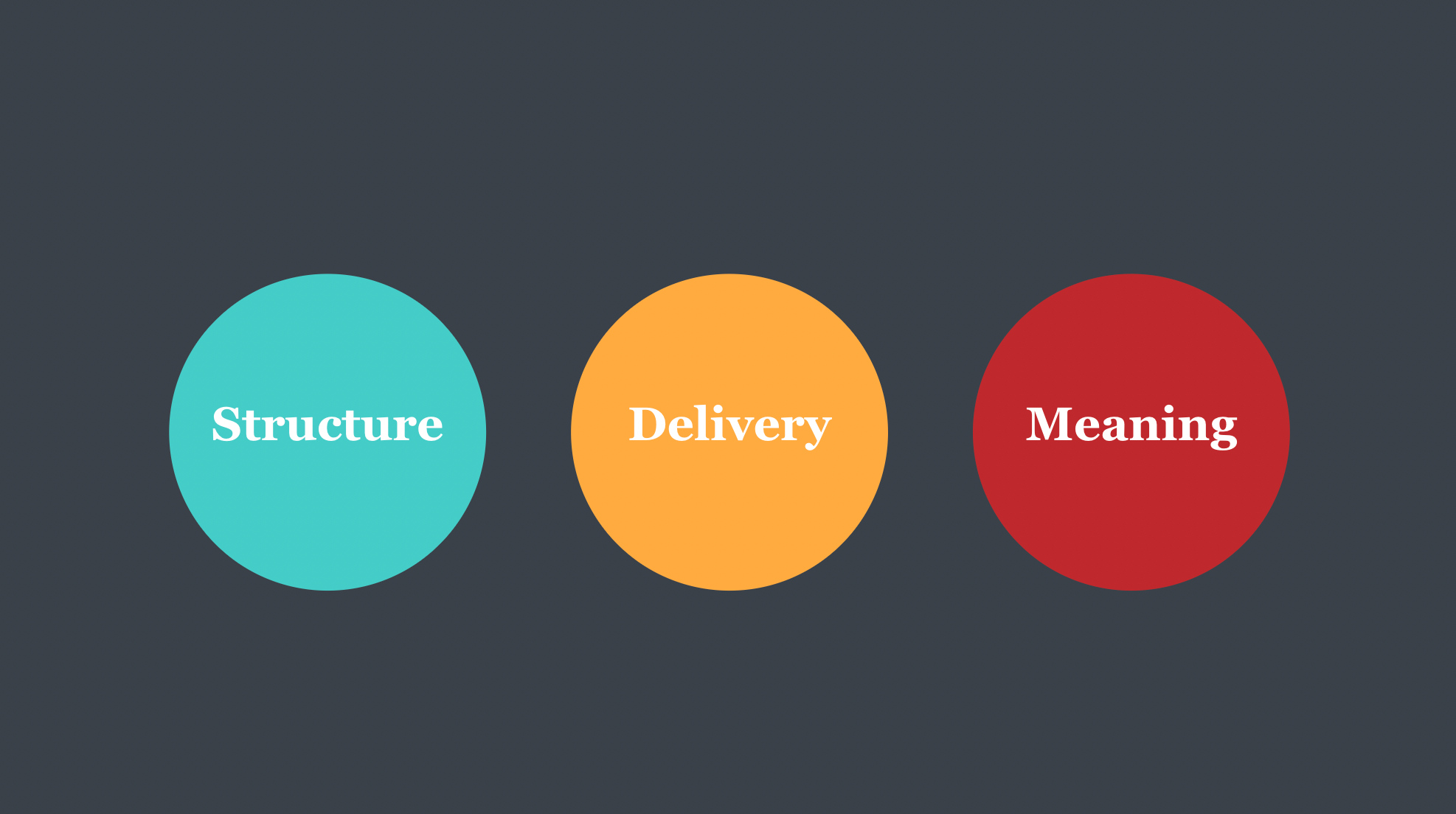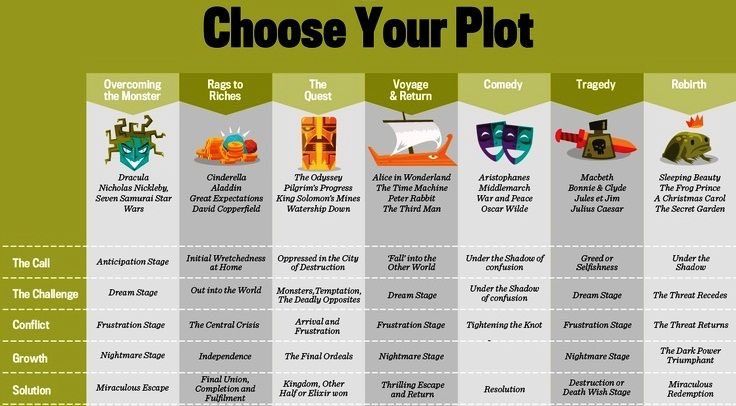Storytelling is a massive subject and can turn into a lifelong journey of studying stories, especially in marketing. There are three key areas that I believe are the most crucial to building and rolling out a great story.
Three categories of marketing stories
I discovered that all the frameworks I was using fit into three clear categories:
- Structure - How to structure an authentic product story to connect perfectly to the perspective of your target consumers.
- Delivery - How to effectively communicate an inspiring and engaging product story with passion.
- Meaning - How to make sure the product story remains authentic and consistent by connecting to your unique brand purpose.

And whenever a story didn't work it was because it lacked one of these three components.
Three tenets to create marketing stories
These three frameworks come with three essential tenets that should always be applied when creating stories for your marketing strategy.
- Understand that stories are in everything. Not just advertising.
- Understand that storytelling is a science that anyone can utilize. Anyone can do it. It’s a learned skill, not just a creative talent.
- The core need is to provide proven frameworks and real business cases. Immediately practice and become the champion of storytelling within your organization.
The storytelling structure
It doesn't matter which framework you use, only that you understand that storytelling is a science, it can be broken down into pieces and understood.
Just like a customer marketer already does with market research or user experience. We will review a few different frameworks to do that. Everything seems complicated and overwhelming until you break it down.
So in this article, we are going to break down stories into segments and explore patterns that emerge. To do that we are going to use one of the most popular and well-known forms of storytelling ….movies.
Storytelling in Fiction
When we think storytelling we usually think about movies. A powerful form of storytelling. What's interesting in this same structure and techniques used in creating movie stories are the same as in every other form of storytelling, including marketing.
Below are two movies that are among the most watched, highest-grossing, and most beloved movie stories of all time.
We are going to break down the structures of these movies to see what patterns emerge and what we can learn from them. Approach them like a customer marketer, review, hunt for patterns, and draw conclusions. What similarities in story structure do you observe between these movies?
The Lion King:
- The Ordinary World: Simba is the heir to the throne of Pride Lands.
- The Call to Adventure: Scar kills Mufasa and tells Simba to leave Pride Lands.
- Refusal of the Call: Simba, scared and alone, retreats to the desert.
- Meeting with the Mentor: Timon and Pumbaa introduce Simba to life in the jungle.
- Crossing the First Threshold: Simba embraces the “hakuna matata” lifestyle.
- Tests, Allies, and Enemies: Nala finds Simba and they fall in love.
- Approach to the Innermost Cave: Nala asks Simba to save the Pride Lands and reclaim the throne.
- The Ordeal: Simba must decide between his life in the jungle and his duty to the Pride Lands.
- The Reward: Mufasa’s ghost tells Simba to return.
- The Road Back: Simba goes with Nala and faces off against Scar.
- The Ressurection: Simba learns Scar killed his father and he throws Scar from Pride Rock.
- Return with the Elixir: Simba ascends Pride Rock and reclaims his throne.
Lord of the Rings:
- The Ordinary World: Frodo lives comfortably in the Shire.
- The Call to Adventure: Gandalf tells Frodo he must Destroy the Ring.
- Refusal of the Call: Frodo is reluctant to leave the world he knows.
- Meeting with the Mentor: Gandal introduces Frodo to the Fellowship.
- Crossing the First Threshold: The Fellowship set off on their journey to Mount Doom.
- Tests, Allies, and Enemies: The Fellowship face the Balrog and Gandalf falls.
- Approach to the Innermost Cave: Frodo goes on alone with Sam.
- The Ordeal: Gollum leads Frodo into Shelob’s lair.
- The Reward: Frodo and Sam sneak into Mount Doom but Frodo is corrupted by the Ring.
- The Road Back: Gollum bites off Frodo’s finger and falls into the volcano with the ring.
- The Ressurection: Sauron is defeated and Sam and Frodo are saved by the eagles.
- Return with the Elixir: Frodo leaves Middle Earth to go to the Gray Havens with the Elves.
Although they might seem on the surface to be very different, all follow very similar story structures. Similar protagonists, similar journeys, similar obstacles, These connections are attributed to one of the most famous studies into storytelling. The hero of a thousand faces by…
The study highlights the progress of the protagonist as the foundation for any story structure. The protagonist can be seen as the true connection between a storyteller and the audience. And the chapters of his journey follow certain familiar steps.
Why? This isn't a coincidence. Our brains enjoy this formula. Because we are able to relate to these challenges and can connect them to our own unique lives and struggles.
Storytelling in marketing
You are probably wondering what any of this has to do with marketing.
The same structure used by Hollywood writers is successfully implemented by the marketing teams for the world's biggest brands. There are dozens of different structure frameworks, most of them an offshoot of the Hero Journey. Each one can help can serve a different purpose.
The three I use most often are The Story Wheel, The Seven Basic Plots, and the Oder Chaod framework. For the purposes of this article, I’ll be going through the seven basic plots and how you can use them in marketing.
Side note: Looking for ways to improve your storytelling skills in customer marketing? This eBook focuses on six areas that’ll help you and your team tell more compelling stories that’ll resonate with your audience:
The Seven Basic Plots
Christopher Booker’s 2004 book ‘The Seven Basic Plots: Why We Tell Stories’ argues that you can boil every single story down to one of seven basic plots. We’re going to run through each.

Plot 1 - Overcoming the monster
For example, Dracula or Star Wars.
A story of good overcoming evil is one of the classic story arcs. Even though we can usually predict the ending, it often involves a lot of drama along the way. This helps to grip the audience and releases that awesome oxytocin we all love.
How can you use this?
What’s your company’s biggest challenge? Who is your company’s arch-nemesis? Use this narrative to train your colleagues about the threats you face. (Cleaning Products for example - Germs as the monster.)
Plot 2 - Rags to riches
For example, Oliver Twist or Cinderella.
The protagonist has humble beginnings. They fight their way to the top. This story is a life journey paved with struggle. They’ll usually face an antagonist, but will eventually turn things around and end up on top.
How Can You Use This?
This simple narrative could be used to describe a character who started off with nothing, but through his tenacity and thirst for knowledge ended up rising to the top! (Price Comparison websites - focus on users enjoying the money saved.)
Plot 3 - The quest
For example, Lord of the Rings or The Wizard of Oz.
The protagonist sets off on a geographical journey, which often results in an unexpected spiritual or emotional journey too.
How Can You Use This?
The Quest is highly suitable for use when completing a learning module. From novice to expert, the learner experiences a thrilling journey into the crux of your content. Alternatively, you could use ‘The Quest’ when explaining in-house career progression. (Babbel - persona; growth.)
Plot 4 - Voyage & return
For Example, Finding Nemo or Alice in Wonderland.
Often found in fantasy, the Voyage and Return plot shows our main character being thrown into new/unknown territories, before returning to normality at the end. Usually, the protagonist is a changed person on their return.
How Can You Use This?
This narrative will wrap around whatever content you like! Have the protagonist start off on a trek to seek some lost item or mystical bounty. Once they complete their quest and find their treasure, it might reveal some hidden knowledge! (Travel ads, airlines.)
Plot 5 - Comedy
For Example, A Midsummer Night’s Dream or Bridget Jones’s Diary.
A comedy is by its nature a light-hearted affair, which drives towards a happy ending. Comedy sticks in our heads. A Pew Research Poll showed that viewers of satirical news shows remembered news stories better than those who watched the actual news!
How Can You Use This?
How about buddying up with your graphic design department and presenting your content in the form of a humorous comic strip? (RedBull, M&Ms - oxytocin on memory.)
Plot 6 - Tragedy
For example, Romeo & Juliet or Death of a Salesman.
Get the tissues handy; we’re about to delve into the teary world of tragedy. A tragedy follows the descent of a character whose life spirals into chaos, or irreversible misfortune.
How Can You Use This?
The ‘Tragedy’ plot type can often be used to illustrate the consequences of undesired behaviors or attitudes within the workplace. This format is perfect for a ‘What Not to Do’ style approach to training. (Charities and life insurance.)
Plot 7 - Rebirth
For example, A Christmas Carol or Groundhog Day.
The rebirth story will usually see the main character begin as a cynic, a criminal, or just a bad egg. Something will happen to them that will change their point of view. In the end, they’ll be a complete humanitarian!
How Can You Use This?
In eLearning, a rebirth can be ideally paired with behavior change. The message is this: You previously did things this way, but doing things another way can result in these benefits! (Gyms, Sports, Adidas, Sustainability.)
The Story Wheel and the Order-Chaos Framework
To learn more about The Story Wheel and the Order-Chaos Framework, Eliot Raynar is the instructor for Customer Marketing Alliance’s Storytelling: Masters.
This course is for anyone ready to boost their storytelling skills to the next level. Whether you’re just starting out in customer marketing, or just want to refresh your knowledge and further understand the science behind a story that sells, this certification is for you.
By the end of the course, you’ll have a comprehensive set of skills needed to create impactful and successful storytelling.




